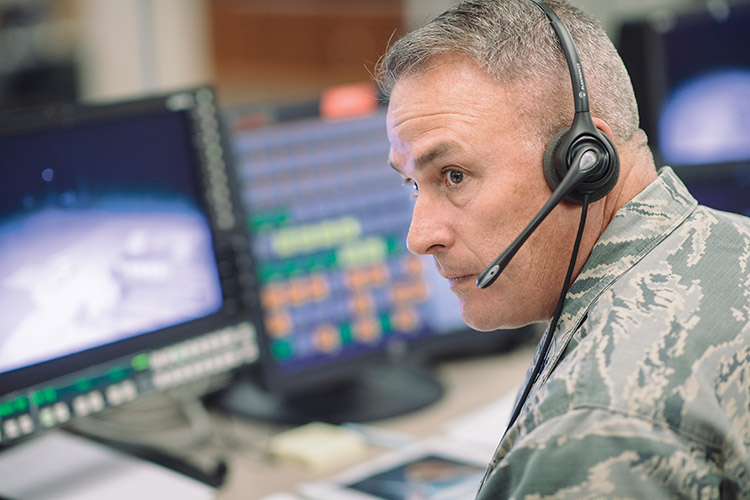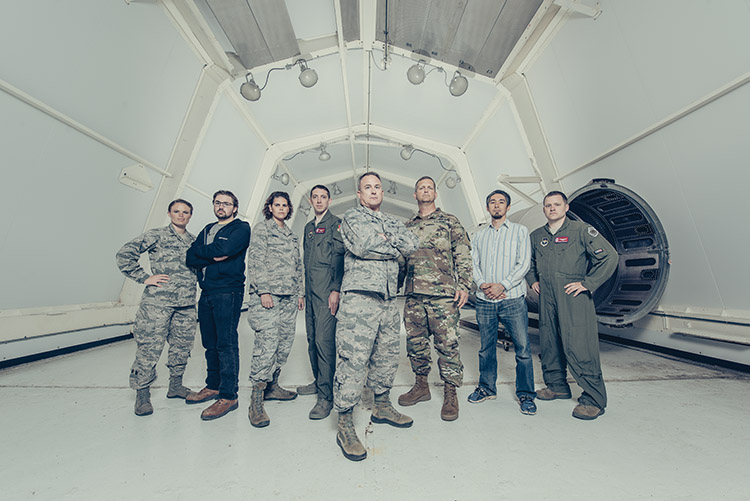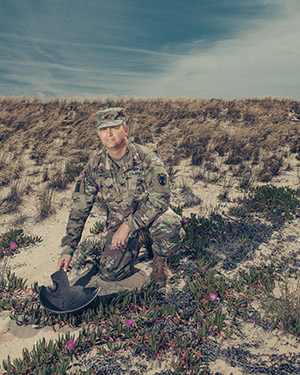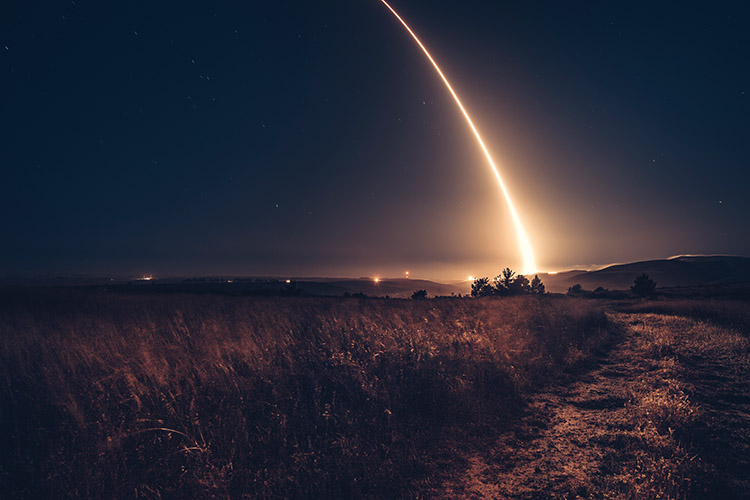The Boilermakers of Vandenberg Air Force Base
One of the first things a young cadet learns is how to properly shine military-issue leather shoes.
ROTC programs are designed to model operational military units for which customs and courtesies — including a meticulously presented uniform — are the foundational basis for etiquette and conduct.
Col. Chris Moss (LA’90), commander of the 30th Space Wing and Western Range, Vandenberg Air Force Base, in central California, fondly remembers shining shoes with his flight, the two dozen junior cadets for whom he served as flight commander in ROTC. In those days, patent leather shoes were a privilege afforded to senior cadets, which meant Friday night gatherings for underclassmen, replete with cotton balls and wax.

“It’s a process. You can’t just shine your shoes and have it be right the first time,” says Moss. “We would have regular shoe shining parties, and they were neat. It gave us a chance to get together and learn who these people are, where they are from, what drives them. I do have fond memories of shining shoes and the lessons that it teaches.”
It wasn’t just about the shiny shoes. Achieving mirror shine was a representation of a cadet’s pride, a symbol of discipline and commitment to the uniform. As the leader of his flight, it was Moss’s responsibility to instill these principles in the younger cadets — one of whom now serves at his side, carrying out the mission at Vandenberg.
“I remember sitting on the floor of Chris’s apartment learning how to shine shoes,” says Col. Greg Wood (AAE’92), vice commander of the 30th Space Wing. “He was my first introduction to the air force and Purdue too, I guess. I showed up for cadet orientation a few days before classes started, and they broke us into flights, smaller groups where we learn and train together.
“He literally taught me how to stand, walk, salute — everything. He took me to Dave’s barbershop in the Village where I could get a military haircut,” says Wood. “I’ve known Chris since the first time I put on a blue shirt. It’s great to be working alongside him again.”
The two crossed paths at Cape Canaveral in the late ’90s but hadn’t worked together directly for nearly two decades until Wood was assigned to Vandenberg in July 2016, midway through Moss’s term as commander.
Fulfilling the Mission
The 30th Space Wing is the host unit of the 99,000-acre base and home to the Western Range, manages Department of Defense space and missile testing, and launches satellites into polar orbit. Vandenberg comprises approximately 2,700 military personnel, 1,300 government civilians, and 3,000 contractors — collectively known as Team V.
There are a number of tenant military organizations assigned to the base, such as the 14th Air Force, the overarching command responsible for performing space operations; the Joint Functional Component Command for Space (JFCC Space), which monitors all objects in Earth’s orbit, defends the nation’s use of space, and provides space support to deployed forces around the world; the 576th Flight Test Squadron, which conducts ground and flight evaluations on intercontinental ballistic missiles (ICBMs); and the 381st Training Group, which provides training for the forces who operate and maintain ICBMs.
In addition to its military mission, the 30th Space Wing leases launch pad facilities to commercial entities SpaceX and United Launch Alliance, a joint venture of Lockheed Martin and Boeing. Between military operations and industry contractors, Vandenberg executes 15 to 20 satellite rocket and missile test launches every year.
As the launch decision authority (LDA), Moss presides over the launch control room in the Western Range Operations Control Center (WROCC). The massive room looks exactly like the ones in the movies where several arcs of consoles aligned in tidy rows are manned by a mix of uniformed officers and plainclothes engineers watching over miniature monitors that blink radar information, generate real-time weather reports, and stream telemetry data. Jumbo video screens dominate the far wall, framed by stacks of countdown clocks that include both local and Zulu time, military parlance for Greenwich mean time.
The LDA sits with other high-ranking leaders apart from the crowd in the “fishbowl,” an elevated room-within-a-room separated from the larger communal space by a glass wall. Keeping the senior officials physically sequestered minimizes distractions and ensures more privacy and less calamity during moments of critical decision-making in the event something goes terribly awry and the long-range missile must be destroyed in flight. It’s an exceedingly rare occurrence, but one that Team V is trained to handle should it arise.

Preparing for Launch
The commander receives routine weather briefs year-round to be alerted to any hazardous conditions that may threaten the range. For the nearly two years he was stationed at Vandenberg, meteorologist Capt. Johnny Martin (S’11) delivered those twice-weekly reports to Moss as a member of the 30th SW Operations Support Squadron Weather Flight.
“I found out the colonel was a fellow Boilermaker right away,” says Martin, who was assigned to lead Moss’s parents, Michael (LA’65) and Patricia (Welch) Moss (LA’66) on a tour of the base. “They asked where I went to school, and that was it.” At the conclusion of his weather briefings, Martin would ask the colonel if he had any questions, to which Moss would reply, “No questions and Go Boilers!” echoed by Martin’s hearty “Boiler Up!”
On launch days, Martin served as weather flight commander and was positioned in the WROCC monitoring atmospheric conditions by parsing data provided by the weather team members situated throughout the base.
“I’d brief the LDA while we were on console,” says Martin, who was reassigned to Oklahoma’s Tinker Air Force Base in March. “Vandenberg is the only place the air force conducts ballistic launches with Minuteman III missiles. It’s very cool to be part of such a unique mission. My favorite part is when Col. Moss says, ‘You’re clear to launch’ just before T minus zero.”
Launch restrictions differ based on the type of vehicle and favorable weather conditions are crucial to a successful mission, but the LDA must assess many different variables to determine whether Team V is clear for launch.
Before a space vehicle is launched from the United States, its flight path is calculated relative to orbital space debris to ensure the route is clear. The minute-by-minute report generated by JFCC Space details safe launch windows to avoid potential collision hazards created by the 20,000 artificial objects circling in Earth’s orbit. A component of US Strategic Command, JFCC Space comprises personnel from the army, navy, marines, and air force as well as multi-national partners. Col. Brian Moore (AAE’93) is the director of operations and exercises for JFCC Space and the highest-ranking army officer currently stationed at Vandenberg.

“The United States government provides a tracking capability that details all of the orbital information for satellites and space debris, such as rocket bodies that haven’t burned in yet,” says Moore. “The data was initially collected for flight safety and in case there were any indications that an adversary was launching something at one of our satellites. But now we share this information with partners all over the world.”
A large portion of the current space debris is the result of an anti-satellite weapon test launched by China in 2007 that collided with an old weather satellite 537 miles above Earth, shattering it into 3,000 pieces. It was the largest known creation of space debris in history.
“The relative speed of a satellite in lower Earth orbit compared to the ground is in the kilometers per second. A vehicle colliding with a satellite is like getting hit with a very fast bullet. It’s going to destroy it,” says Moore.
The air force has 38,000 airmen — roughly 10 percent of its forces — assigned to Space Command, compared to around 300 space soldiers across the army. Moore is used to being the token army guy in the command. After his first decade in military intelligence, he served at the Pentagon, in space and missile defense, and in deployments as a deputy director of space at Al Udeid Air Base, Qatar, and the senior space officer for US forces in Iraq. The fact that Moore has worked extensively with the air force as an army space officer is a bit of karmic justice. As a senior in high school, he initially applied for a four-year scholarship through Air Force ROTC.
“The air force turned me down back in 1988,” he says. “For whatever reason, they thought I didn’t have any potential.” That spurred Moore to try the army. “I went to my first lab at the Armory. We went over to Hort Park and were crawling through the mud, running with guns, and I absolutely loved it. I thought, ‘I want me some of this army.’”
Fundamentally, the Army boils down to a people business. The air force maneuvers through planes and satellites, the navy through ships and submarines, but the basics of the army is the infantry, the soldier. It’s an individual human being. “That whole four-year process of ROTC, there’s a reason they call it a leadership lab,” says Moore. “You learn to be a follower and you learn to be a leader. You learn to be a team player.”
At the Ready
Elsewhere on the base, a half-dozen airmen dressed in olive-green flight suits are seated at consoles in a chilly climate-controlled room inside the ICBM Launch Support Center. Among them is Capt. Albert Chaney (AAE’08), an ICBM ground test section chief with the Air Force Global Strike Command’s 576th Flight Test Squadron, who recently experienced his first launch of a Minuteman III. “When the countdown got down to T minus two, my heart rate went up a bit,” he says. “I got pretty excited. This is what I was trained to do.”
As a missileer, Chaney is more familiar with the ICBMs than the majority of people on the base. He’s a highly trained specialist who has spent countless hours studying missiles and sitting on alert monitoring the status of the country’s nuclear arsenal “up north” — 450 ICBMs that have been buried in the airfields surrounding Malmstrom AFB, Montana; Minot AFB, North Dakota; and FE Warren AFB, Wyoming; since the 1970s. Missileers stationed at these remote bases work shifts in underground launch control centers to monitor and man the missiles in their squadron 24/7. Should the president of the United States issue the order, Chaney would be part of the team that turns the keys to release the most powerful weapons on the face of the planet.
A few times a year, one of the Minuteman IIIs is retrieved at random from its silo and trucked to California to be fired in a test launch from Vandenberg — warhead removed and replaced with tracking and telemetry instruments. These missions are part of the ongoing program to test the effectiveness, readiness, and accuracy of the weapon system.
“These Minuteman launches are essential to verify the status of our national nuclear force and to demonstrate our national nuclear capabilities,” says Moss. “Successful testing gives us confidence that the ICBMs on alert back in the missile silos will be ready to work if we ever need them.”
At Vandenberg, Chaney’s role as launcher environmental protection system control and monitor operator means he’d be the one to stop the test missile from launching should it fail any systems checks. That wasn’t the case on April 26, when no faults were detected and the weather was favorable. The LDA declared Team V clear to launch at 12:03 a.m. Only a few minutes into the six-hour launch window for the mission, an unarmed Minuteman III ICBM was fired from Launch Facility No. 9 (LF-9) into the starry sky.
Clear for Launch
Located about four miles away from LF-9, the Ronald Reagan Memorial Observation Site provides an impressive view of the missile’s trajectory from a safe distance. Minutes after midnight, a bright orange glow illuminates the horizon as the hydraulically operated hatch slides open. Within seconds, the missile shoots out of its silo, leaving a vibrant trail of light in its wake. It soars impossibly high before the rumble from the rocket boosters rolls over the prairie and is audible at the viewing site. At speeds exceeding 15,000 mph, the Minuteman III’s re-entry vehicle, equipped with tracking and telemetry system, only takes 30 minutes to travel about 4,200 miles to the Kwajalein Atoll in the Marshall Islands, where its expendable rocket boosters splash into the Pacific Ocean and become part of the reef.

A group of onlookers gathers at the observation site to watch the launch. Among them is Col. Moss’s wife, Brenda (Trisciani) Moss (AAE’90). A retired space officer, Brenda Moss served eight years active duty followed by another 12 in the Air Force Reserve, rising to the rank of lieutenant colonel. She has unique insight into her husband’s work as LDA, as she was a launch control officer herself. She led teams in space launch missions based out of Cape Canaveral in the late ’90s.
“Purdue’s association with the US space program through its many astronauts is common knowledge,” says Brenda Moss. “But there is another prominent contingent of alumni supporting the US space program within the air force and Air Force Space Command. Our family has served in the air force since we left Purdue, and we are so passionate about how our education effectively prepared us and our fellow Detachment 220 Air Force ROTC graduates.”
While Brenda and Chris Moss were in the same cadre of ROTC cadets, they didn’t really become acquainted until second semester of their freshman year in Physics 152. The introductory course, required for first-year engineering students, was known as a “weed-out” class. Brenda, the more technically minded of the two, stayed the course to earn a bachelor’s in astronautical engineering. Chris changed his degree objective to major in history the following year.
“Personality-wise, the liberal arts are more my thing,” says Chris Moss, who went on to earn master’s degrees in national security affairs and airpower art and science through the air force. “I believe that as a military professional, a historical perspective is an important thing to have. The air force has a lot of very technical people, and they are brilliant. But there are elements of leadership that come from the liberal arts and understanding how people work, how institutions work, and how our nation makes decisions because of its history. The ideal officer is someone who can do a little bit of both.”
In addition to sharing the feeling of being called to serve in the military, the Mosses also bonded over Boilermaker basketball. Chris recalls how they slept overnight outside Mackey Arena their sophomore year in the hopes of nabbing a pair of season tickets. Purdue was ranked preseason, and the seats were a hot commodity, so when it was announced than an additional 500 tickets were available, he chose to camp out instead of preparing for an early morning ROTC uniform inspection.
“The next morning, I ran home, threw on my uniform, and ran to the inspection,” he says. I looked like garbage, and I remember my freshman flight commander really let me have it. He clobbered me for not being in standards. It was the classic drill sergeant moment, where he’s yelling at me, ‘What’s your excuse?’” So Moss told him, “Sir, I got basketball tickets.” After a moment’s hesitation, the flight commander looked at Moss and replied, “Good enough.”
He still watches basketball and now follows his favorite teams alongside the couple’s youngest son, AJ. Daughter Sarah is a figure skater who will start at Miami University, Ohio, in August. Their eldest, John, is studying computer science at the University of Wisconsin–Madison.
Next Chapter
Air Force officers receive new assignments about every two years, which often means uprooting their families to move to a different base in another state. The command post at Vandenberg is the pinnacle of Col. Moss’s distinguished 27-year career in the service. He retires from active duty this summer, and his next assignment is one of his own choosing. The Moss family will be relocating to the suburbs of Phoenix, Arizona, where he will start in July as director of the American Leadership Academy, a public charter junior/senior high school in Queen Creek. Son AJ will enroll in eighth grade there this fall.
“Brenda and I have always said we will stay in the air force so long as we’re good for the air force and the air force is good for us,” says Moss. “We’ve just come to a point where it seems right to transition family-wise and career-wise. I am very proud of my air force service and grateful for what the air force has done for us as a family, but this feels like the right time. So we’ll move on and learn what life is like on the outside.”
Moss fulfilled his final duty as an officer of the air force on June 9 during a change-of-command ceremony held on Vandenberg’s parade grounds. He presented the flag signifying command of the 30th Space Wing and Western Range to his commanding officer, who, in turn, presented it to the succeeding wing commander. The colonel was decked out in his service dress uniform, including a pair of oxford lace-ups that he shined himself.
“The side seam recently split on my patent leather shoes,” says Moss. “So I went over to the clothing sales store to buy a new pair of shoes. As a matter of principle, I bought an old-fashioned pair of leathers. As I end my time in the air force, I was adamant that I would leave by shining my shoes, the same way that I started.”
Kat Braz (LA’01) is editor of Purdue Alumnus magazine.

